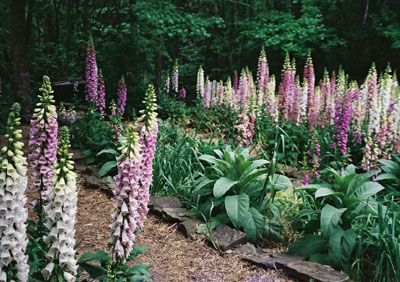Adaptation
Foxgloves have made many adaptations to survive and thrive in their environments. For example, they have adapted to acidic soil. Now, if the acidity of the soil is not right, chlorosis will occur in the plant. When this happens, the leaves usually turn yellow because of the lack or nutrients. Leaves with chlorosis to not contain chlorophyll, which they need for photosynthesis to make their food. Eventually, foxgloves with chlorosis loose their leaves and die.
Along with adaptations to soil, they have also adapted their
nectar. Foxgloves have a high nectar content. This helps them
attract bees, butterflies, and even hummingbirds. This is an
important adaptation because when these other organisms feed on the
nectar of the foxglove, pollen attaches to them. Then they go off to
other plants, spreading the pollen of the first foxglove, thus
aiding in the foxglove's fertilization.

Additionally, to help protect themselves from other organisms, the foxglove produces a toxin called digitalis. This is a poisonous substance and can be deadly. Due to this, many grazing animals like deer and rabbits avoid the foxglove. Every part of the plant is poisonous and it is poisonous during every part of the plants life cycle. However, they are most poisonous right before their seeds ripen and leaves that are further away from the ground are more poisonous then leaves closer to the ground.
The foxglove also has a very tall stalk. The stalk can range up to 2 to 7 feet. This helps them in the competition for light with other plants. It helps them receive more light for photosynthesis, compared to other shorter plants like the.
Next to learn more about how they acquire their nutrients go here Nutrition.
This picture is courtesy of The Cedar Hill Report and Paula Mariedaughter